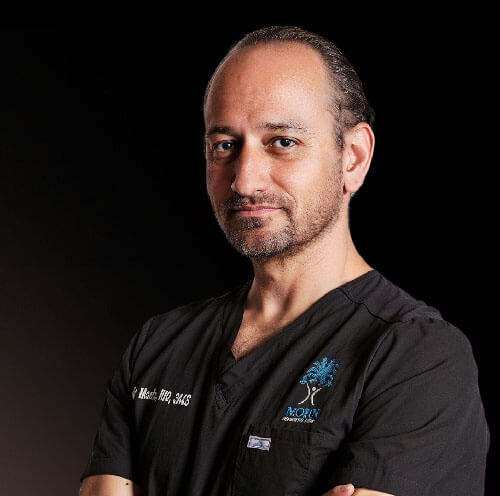
Understanding Lap Band Revision to Gastric Sleeve in Los Angeles, CA
A laparoscopic adjustable gastric band (Lap-Band) is an inflatable device around the stomach's top portion. The purpose of the surgery is to treat obesity by restricting food consumption. The first lap band was surgically placed on September 1st, 1993. From that point onward, bariatric surgery steadily rose in popularity until it became the favorite option for weight loss specialists and patients.
But then something happened. Patients started having problems with the lap band. Either the procedure failed to deliver the intended results, or complications occurred. This led to the procedure falling out of favor around 2011.
If you have been fitted with a Lap Band, you may find that you are still obese. Or you may be experiencing complications. Either way, you may wonder, “What’s next?”
The good news is that all hope is not lost. Bariatric science has developed numerous methods for helping patients lose weight when the Lap-Band has failed to work effectively.
Please keep reading to learn more about Lap Band Surgery, why it does not work in many cases, and how you can go forward if you care about your health and still have weight to lose.
Don’t want to wait until the end? You can find answers immediately by calling Healthy Life Bariatrics to schedule a discreet consultation with the world-renowned bariatric specialist, Doctor Babak Moeinolmolki. Call our office now in Los Angeles at (310)861-4093.
What is Adjustable Laparoscopic Banding (Lap-Band) Surgery?
The Lap-Band is intended for obese patients who have tried and failed to lose weight using diet and exercise alone. Patients qualify for the Lap-Band with a body mass index (BMI) of 40 or greater. You can also be eligible for Lap Band surgery if you have a BMI of 35 or 40 with one or more obesity comorbidities such as diabetes, sleep apnea, GERD (gastroesophageal disease), and hypertension (high blood pressure).
The Lap Band device is fitted laparoscopically. Small incisions are first placed around the abdomen. These cuts function as insertion points for a telescopic camera and other surgical tools. The camera lets the surgeon view the internal organs via a nearby monitor. The different tools are used to place the inflatable device, which separates the stomach into two smaller pouches.
How Does the Lap-Band Work?

With the Lap-Band in place, the patient's food is consumed slowly. The amount of food is also restricted. The patient is forced to eat smaller portions and begins to feel full much sooner than before.
By eating less and feeling less hungry, Lap-Band wearers enjoy sustained weight loss, particularly when the Lap-Band is coupled with healthy eating and a consistent exercise routine. At least, that is how the Lap-Band is supposed to work.
We now know that the Lap-Band is associated with quite a few unredeemable problems. Only some people with a Lap-Band experience complications, but enough do that bariatric surgeons are more apt to prescribe a different and more effective bariatric surgery.
This is disappointing in many ways because the Lap-Band was supposed to be a medical wonder. It offers a lower mortality rate than the Roux-en-Y gastric bypass surgery (only 1 in 1000 versus 1 in 250), there is no cutting or stapling of the stomach, and the surgery comes with quick recovery.
But complications can occur. Let’s examine those now.
Why is the Lap-Band Associated with So Many Complications?
Like other surgeries, the Lap-Band comes with risks. Common risks include ulceration, erosion (where the band slowly migrates through the stomach wall), slippage, and malposition of the band over time.
Other adverse effects of the band include infection of the fluid within the band, abdominal pain, fever, hernia, constipation, diarrhea, nausea, vomiting, alopecia, hair loss, pancreatitis, and more than a dozen others.
Because of the risk of so many complications, and inadequate weight loss, the Lap-Band comes with an elevated chance of the need for a revision bariatric surgery, usually within a period of 7 to 10 years.
As you can imagine, bariatric surgeons are not likely to recommend Lap-Band surgery because of these issues.
How Do You Know If You Qualify for Lap-Band Removal?
The greatest indicator that you might qualify for Lap-Band removal is if you fail to lose weight to the point of defeating obesity. Bariatric surgeries are intended to help you lose weight quickly. Having the desired procedure is like flipping a switch. Whereas before, weight loss was nearly impossible, bariatric procedures make it possible to lose a majority of your weight within the first one to two years.
These surgeries aren’t only about looking better. The main focus is health. Being overweight to the point of obesity places a strain on your body. Your bones and joints can form osteoarthritis. Your organs are forced to work overtime. Obesity also makes you susceptible to over 60 obesity weight-related ailments. You are also more likely to have a heart attack, stroke, and develop several types of cancer.
Losing weight with bariatric surgery puts you at less risk for these illnesses and can increase your life span as a result. Unfortunately, Lap-Band surgery may not deliver the amount of weight loss you expect.
Other indications of lap-band removal include vomiting, difficulty swallowing, and pain after eating. These symptoms can be signs that the band has slipped or is ill-tolerated by your body. You may develop a band or port infection (the port inflates the band following installation).
What Are Your Options if You Have Been Fitted with the Lap-Band?

If you have a laparoscopic lap-band and cannot lose weight or experience complications, laparoscopic lap-band removal is the next logical step. The procedure for removing the band is performed laparoscopically, the same as the means by which it was installed. Revising bariatric surgery is relatively safe and easy, depending on existing complications.
Removing the adjustable band involves small incisions and the insertion of laparoscopic tools. The surgeon can use the old incisions to limit scarring. Once the abdomen is accessed, the surgeon cuts the scar tissue that has formed around the band. The tubing and band themselves are then cut to make them easier to remove. The materials are pulled through the same incisions.
During the first surgery, the upper part of the stomach (known as the fundus) is sutured. The purpose of the sutures is to prevent the band from migrating up or down. Some bariatric surgeons choose to leave the sutures in place during the Lap-Band removal procedure. Others prefer to remove the sutures and lyse the adhesions. Once this last step is performed, the original anatomy of the stomach will be restored. It will make the revision of bariatric surgery easier.
The last step is to remove the dense scar tissue around the upper part of the stomach or esophagus (called the perigastric capsule), followed by the removal of the subcutaneous port.
With all the components and scar tissue taken out of the body, the patient can then choose to transition to a more effective bariatric surgery. One of the most popular procedures chosen for this purpose is the laparoscopic sleeve gastrectomy (LSG), otherwise referred to as gastric sleeve surgery.
Read our article: Holiday Weight Loss is Possible with LSG (Laparoscopic Sleeve Gastrectomy)
The transition from the Lap-Band to Gastric Sleeve Surgery
Lap-Band to gastric sleeve surgery is recommended for patients who have failed to lose weight or experienced complications after the initial gastric banding surgery. Many patients either failed to lose weight entirely or regained 40% of their lost weight.
One of the reasons Lap-Band weight loss is often difficult is because the stomach remains whole. Even though the stomach is separated into two halves, the patient can choose to eat normally. This can cause the stomach to stretch, making the Lap-Band ineffective. This is not the case with gastric sleeve surgery.
With gastric sleeve surgery, the same laparoscopic techniques are put to good use. Small incisions are used as entry points for the camera and other tools. Once the bariatric surgeon has access to the stomach, up to 80% of the stomach tissue is removed. The portion removed is the fundus, mainly responsible for producing the hunger hormone ghrelin. The remaining stomach tissue is fashioned into a banana-shaped sleeve. This change to your digestive system limits how much you can eat and makes you less hungry overall. The weight tends to come off quickly since you feel less hungry, are forced to eat less and feel fuller faster during meals.
Whereas Lap-Band patients can “Trick the Band” by eating normally, this is impossible with the gastric sleeve. The loss of the stomach tissue is permanent, unlike the reversible laparoscopic gastric banding. This means food restrictions are put in place for the long term, making weight loss inevitable.
How is Gastric Sleeve Surgery Better Than the Lap-Band?

The most significant difference between Lap-Band and gastric sleeve surgery is the weight you can lose. Lap-band patients are often assured they can lose up to 40% of their starting weight. As we have demonstrated, this is only sometimes possible. Some patients end up losing some weight only to gain back all the lost weight and then some.
Gastric sleeve surgery, on the other hand, can lead to a loss of up to 60% to 70% of your excess weight. That means if you are a hundred pounds overweight, you stand to lose up to 60 to 70 pounds or more.
Another significant benefit of gastric sleeve surgery is that the procedure is associated with minimal risk of complications. Of course, all surgeries come with risks, but the gastric sleeve is considered highly safe and effective compared to other bariatric surgeries.
Common risks of the laparoscopic sleeve gastrectomy include infection, excessive bleeding, blood clots, adverse reactions to anesthesia, breathing problems, and leaks from the cut edge of the stomach. Longer-term risks can include gastrointestinal obstruction, hernias, GERD, and vomiting. These complications are rare.
You can further lessen your chance of developing complications following gastric sleeve surgery by choosing your bariatric surgeon carefully. There are many gastric sleeve specialists from which you can choose. When consulting with a surgeon, make sure you ask about education and experience and ask to see before and after photographs that indicate a high degree of satisfaction with patients in the doctor’s care.
Transform Your Weight Loss Journey with Lap Band Revision to Gastric Sleeve in Los Angeles, CA
What if You Don’t Qualify for the Sleeve Gastrectomy?
This post's purpose is to relay that the lap band is only sometimes the best solution when diet and exercise fail to move the numbers on the scale. The secondary purpose is to let you know that options are available if you have already been fitted with the Lap-Band and still want to lose weight.
It should be noted that there are cases where the Lap-Band is still prescribed to patients who are suffering from the disease of obesity. If you fail to qualify for the gastric sleeve, either because you do not have a high enough BMI or have a preexisting condition that makes the gastric sleeve unsafe, the Lap-Band may be the best way to lose weight and attain optimal health.
The Bottom Line: Lap Band Revision to Gastric Sleeve
By now, you know more about the lap band, how bariatric surgery works, and why it has since fallen out of favor. You also know that gastric banding can be transitioned to a more effective technique, such as the gastric sleeve or laparoscopic sleeve gastrectomy (LSG).
I'm still looking forward to learning more. Are you fitted with a Lap-Band and find yourself desperate for alternative solutions? Or are you considering weight loss surgery and don’t know where to turn?
Schedule Your Consultation for Lap Band Revision to Gastric Sleeve Los Angeles, CA Today
You can find the help you need by scheduling a consultation with Doctor Babak Moeinolmolki of Healthy Life Bariatrics in Los Angeles, California. Doctor Moeinolmolki has extensive education and experience working with patients affected by the disease of obesity. From the Lap-Band and gastric sleeve to other procedures like Roux-en-Y gastric bypass surgery and the duodenal switch, Doctor Moeinolmolki wants to be your Southern California bariatric specialist. Look at the doctor’s before and after gallery before calling to schedule your discreet consultation at (310)861-4093.

